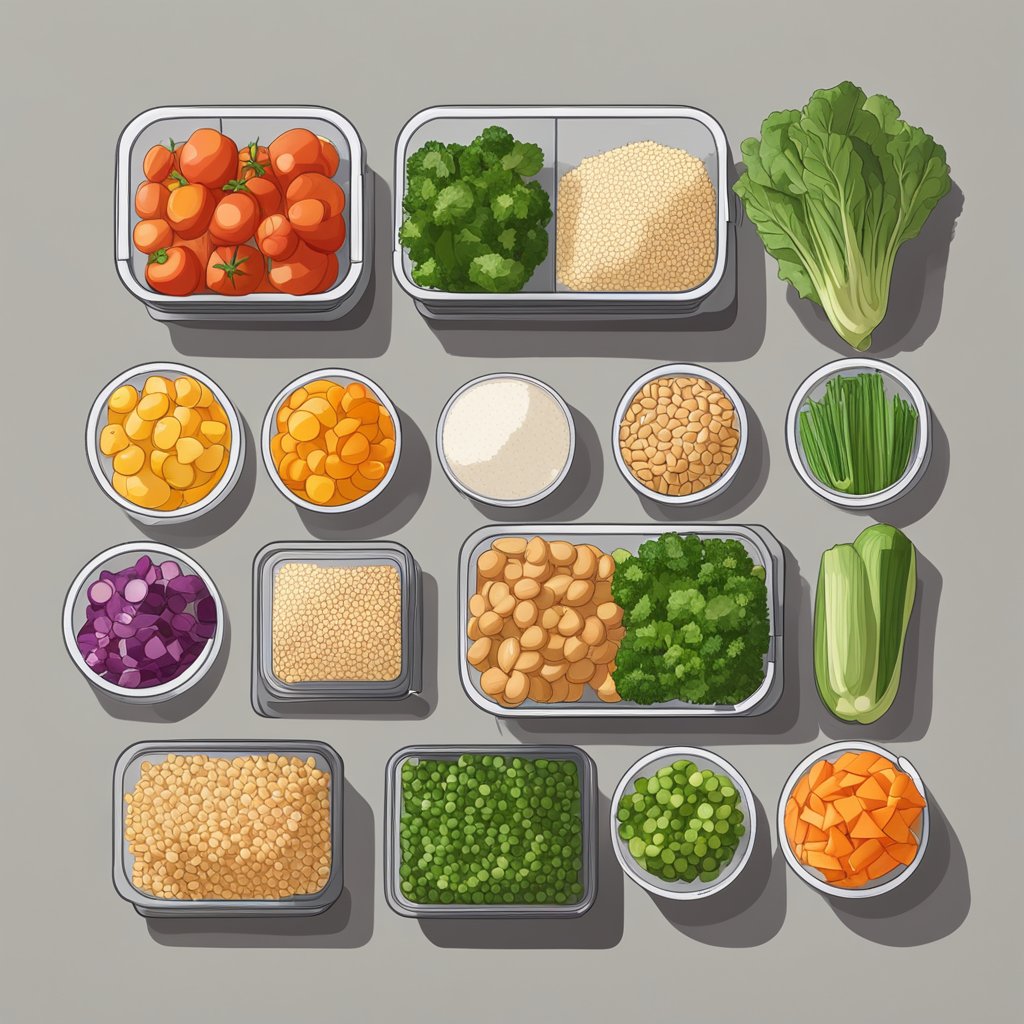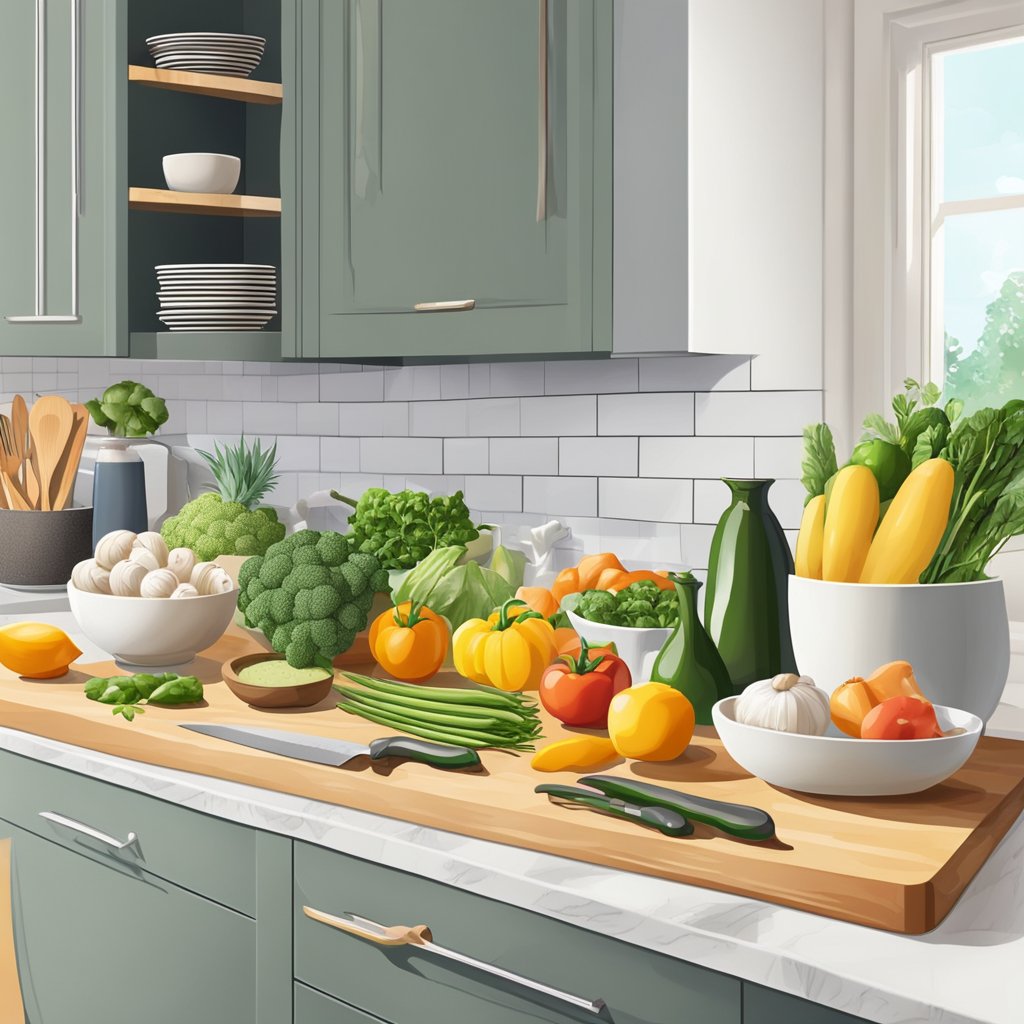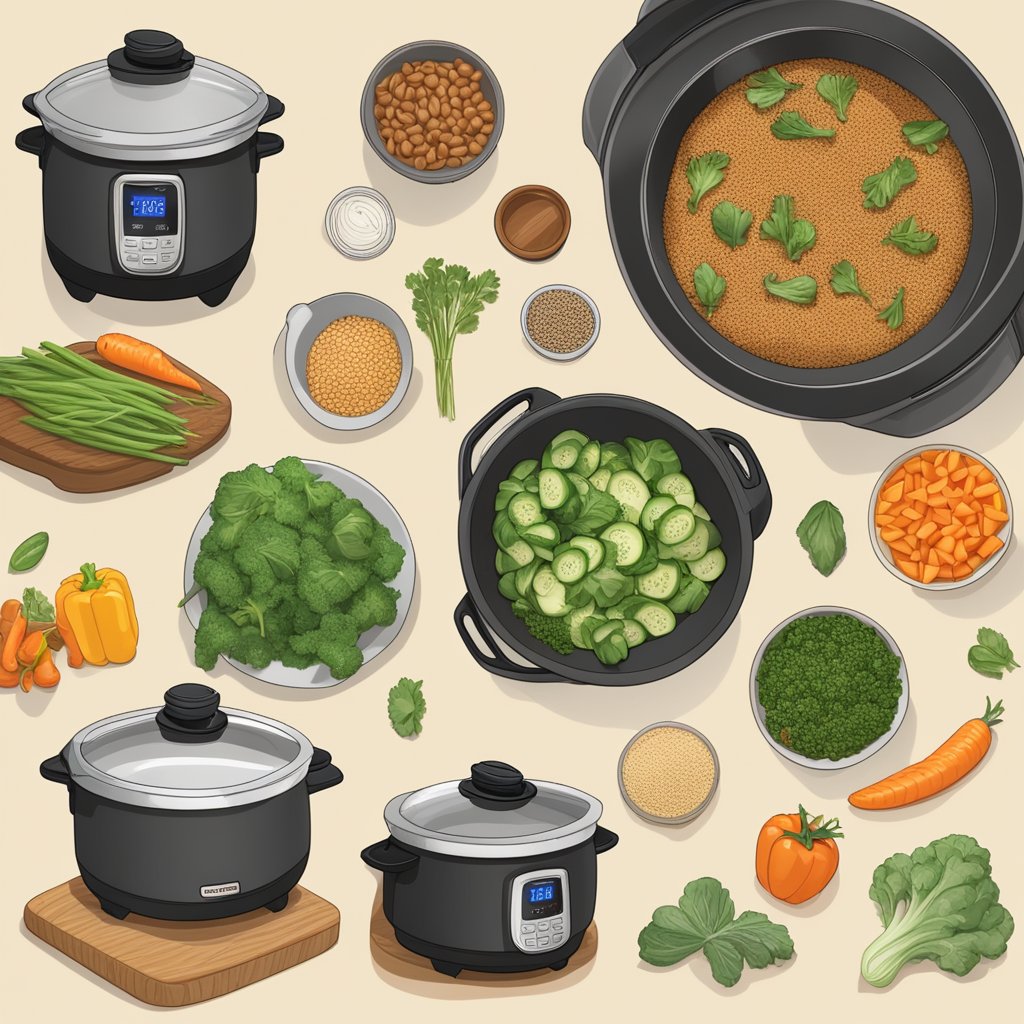Meal prepping, or meal planning, is a versatile approach to managing your diet. It accommodates a busy lifestyle. By preparing your meals in advance, you ensure that you have healthy options readily available. This can prevent you from resorting to less nutritious, on-the-go solutions. This strategy is not just about saving time. It’s also a conscious choice to prioritize your health and dietary goals. It gives you control over the ingredients, portion sizes, and nutritional balance of your meals.

Embarking on a weekly meal prep routine can seem daunting at first. However, with a bit of planning, it becomes an efficient and sustainable part of your weekly schedule. It allows you to batch cook several days’ worth of meals, saving you time and effort throughout the week. You can tailor your meal prepping to fit your specific dietary requirements. This can include losing weight, gaining muscle, or simply maintaining a balanced diet.
To get started with healthy meal prep, begin by selecting recipes that are both nutritious and satisfying. Investing in quality containers that keep food fresh is also key. Allocate a block of time each week to shop for ingredients, prepare dishes, and portion out your meals. Consistent meal prepping can transform your approach to eating. It makes it easier to stick to healthy habits even on your busiest days.
Benefits of Meal Prep
When you embrace meal prepping, you take control over your nutritional intake. This allows you to manage your diet more effectively. You can tailor your menu to include a balanced mix of macronutrients and healthier ingredients that align with your personal fitness goals or dietary restrictions by planning your meals.
By preparing your meals in advance, you avoid impulsive choices. These choices often lead to unhealthy fast-food options. Design your weekly meal plan to be both nutritious and satisfying. This is vital for maintaining a healthy lifestyle.
- Dietary Consistency: proportion and balance each meal, helping you stay on track.
- Allergy Management: Tailor meals to avoid specific ingredients if you have dietary restrictions.
Budget-Friendly Meal prepping is cost-effective. Buying in bulk and cooking at home saves money compared to dining out. You can monitor your grocery bills and reduce food waste by utilising everything you purchase.
| Quantity Buying | Cost Savings |
|---|---|
| Bulk Purchases | Reduced Prices |
| Targeted Shopping | Less Impulse Buying |
Time Efficiency Allocating a few hours to prepare meals for the week means saving time later. Your routine becomes streamlined. Meals are ready to go, cutting down on daily cooking time.
- Quick Access: Grab-and-go meals from the fridge or freezer, reheat, and eat.
- Less Cleaning: One cooking session equals fewer dishes throughout the week.
In summary, meal prepping helps you stick to a routine that supports a healthy diet and budget. It also saves time. It’s a purposeful strategy. It empowers you to eat better, save money, and manage your day more efficiently.
Getting Started with Meal Prep

Successful meal preparation begins with understanding the essentials of combining nutrition, taste, and variety. With the right ingredients and recipes, and smart grocery shopping habits, you can create a meal plan. It will enhance your diet and fit your budget.
Essential Ingredients and Recipes
To build a solid foundation for your meal prep, focus on these core categories:
- Proteins: Select a variety of proteins for balanced nutrition. Choose from lean meats, poultry, fish, tofu, beans, lentils, or eggs.
- Vegetables: Emphasize a range of colors to maximize the variety of nutrients. Fresh vegetables should dominate your selection.
- Grains: Incorporate whole grains such as brown rice, quinoa, barley, or whole wheat pasta. They provide sustained energy.
When selecting recipes, prioritize healthy options that will bring diversity to your meals. Utilize these core ingredient categories. By preparing a few versatile recipes in advance, you create the building blocks for a week’s worth of complete meals.
A few recipe suggestions:
| Category | Recipe Ideas |
|---|---|
| Proteins | Grilled chicken, lentil stew |
| Vegetables | Roasted carrots, sautéed spinach |
| Grains | Quinoa salad, brown rice stir-fry |
Add different herbs and spices to simple, healthy recipes. It will add excitement without adding excess calories.
Smart Grocery Shopping
Strategize your shopping trips to save time and stick to your budget:
- Plan Ahead: Create a detailed grocery list based on your selected recipes. This will help you avoid impulse buys.
- Buy in Bulk: Purchase non-perishables, such as whole grains and legumes, in bulk quantities for cost savings.
- Freshness First: When at the grocery store, prioritize the purchase of fresh vegetables and lean proteins.
- Sales and Seasons: Take advantage of sales and seasonal produce which can be more affordable and at peak freshness.
Remember to stay flexible with your shopping list—a great sale or an unexpected find at the grocery store can inspire a new meal prep recipe that still fits into your plan.
Food Storage Solutions
Proper food storage is essential in meal prepping. It extends shelf life, reduces food waste, and ensures safety. The right containers are crucial for maintaining quality and adhering to food safety guidelines. Proper reheating techniques are also crucial.
Choosing the Right Containers
When selecting meal prep containers, your primary focus should be on durability and seal quality. Airtight containers are ideal as they prevent the ingress of air, which can spoil food quickly. If you plan to frequently switch between freezing, refrigerating, and reheating meals, choose glass containers. Temperature changes are less likely to damage them. Consider the following for container selection:
- Freeze: Use containers that seal tightly to avoid freezer burn. Look for labels indicating ‘freezer-safe’.
- Fridge: Prioritize transparent or semi-transparent containers. They make it easy to identify the contents and monitor your food stock.
Glass containers are best for use in the fridge, freezer, and reheating. They are durable, non-reactive, and clear. Plastic (BPA-free) containers are best for the fridge and cold storage. They are lightweight and shatter-proof. Silicone containers are best for the fridge and freezer. They have a collapsible, space-saving design. Stainless steel containers are best for the fridge and dry storage. They are durable and rodent-proof.
Replace cracked, discolored, or deteriorated seal containers. They can compromise food safety.
Reheating and Safety Guidelines
When reheating meals, ensure the food reaches an internal temperature of 165°F (74°C) to safely consume. Follow these food storage and reheating safety steps:
- Fridge Storage: Keep your fridge below 40°F (4°C) to inhibit bacterial growth.
- Reheat: Use oven-safe glass containers or microwave-safe containers without lids. Stir occasionally for even heat distribution.
- Thawing: Safely thaw food in the fridge or in cold water, never on the countertop.
Remember to cool your cooked food before transferring it to the fridge or freezer. This prevents raising the internal appliance temperature. To hasten cooling, you can place food in shallow containers. Always label your containers with the date of storage. This will help you keep track of their longevity. To minimize waste, prioritize food that was stored first.
Healthy Meal Prep Ideas
Planning your meals for the entire day ensures variety and aligns with nutritional goals. This applies whether you adhere to specific dietary preferences or seek general healthy eating habits.
For Every Meal of the Day
- Breakfast: Prepare overnight oats with chia seeds for a protein-packed start to your day. Simply mix oats, chia, your choice of milk, and a sweetener. Refrigerate the mixture overnight.
- Lunch: Craft a salad with an assortment of greens, cherry tomatoes, and cucumbers. Add a lean protein like grilled chicken breast. Dress it right before eating to maintain freshness.
- Dinner: You can portion and freeze make-ahead meals, such as slow-cooked chili. They offer you satisfying dinners on demand. You can defrost them overnight and reheat when you’re ready.
- Snacks: Pre-cut vegetables or fruits stored in individual containers are convenient. Pairing them with dips or nut butters adds a flavorful protein boost.
Here are some meal ideas. For a healthy breakfast, you could make overnight oats or fruit parfaits. You could also make egg muffin cups. For lunch, you could make mason jar salads or quinoa bowls. You could also make wraps. For dinner, you could make chili, casseroles, or stir-fries. As snacks, you could have hummus with veggies, yogurt, or mixed nuts.
Special Dietary Preferences
- Vegetarian: Quinoa stuffed bell peppers—fill with a mix of quinoa, black beans, corn, and cheese. They’re hearty and nutritious.
- High Protein: Bake a batch of turkey meatballs or prepare grilled fish fillets to add a lean protein punch to any meal or salad.
For easy meal prep ideas, rely on simple ingredients. You can cook them in bulk and season them in different ways throughout the week. This will keep meals interesting and your diet varied. Think roasted vegetables, brown rice, or whole wheat pasta.
Remember to choose fresh, whole food ingredients that align with healthy eating practices. Always vary your types of foods to supply all the nutrients your body requires.
Efficient Cooking Methods

When meal prepping, adopt cooking methods that save time and energy without compromising meal quality.
Batch Cooking: This is an effective strategy where you cook large quantities of a certain recipe at once. To do this efficiently:
- Plan your recipes in advance.
- Prepare all the ingredients before starting.
- Use large pots or baking sheets.
- Store your cooked meals in well-sized containers for refrigeration or freezing.
Slow Cooker Usage: Employing a slow cooker can offer convenience and energy efficiency. Here’s how:
- Prepare multiple meals by layering ingredients differently.
- Opt for recipes with similar temperature and time settings to save monitoring time.
- Take advantage of ‘low’ settings overnight or ‘high’ settings for faster results.
Individually Portioned Meals: After cooking, divide your meals into individual portions. This process:
- Facilitates quick reheating.
- Helps with serving control.
- Makes it easier to grab a meal on-the-go.
Cooking Multiple Meals: If you’re preparing different dishes, consider:
- Using the oven to cook multiple items at once, adjusting temperatures and rack positions.
- Prepping side dishes that work with more than one main.
- Chopping or marinating ingredients for various meals together.
Tools & Techniques: Efficient tools, like pressure cookers or air fryers, speed up cooking time and use less energy. Utilize meal prep techniques such as:
- Chopping vegetables in bulk.
- Pre-seasoning proteins.
- Pre-cooking grains to pair with various accompaniments.
By following these methods, you can streamline the meal prepping process. This will ensure a steady supply of home-cooked meals that support your dietary goals and schedule.
Meal Prepping Frequently Asked Questions:
Q: Is it OK to meal prep for 5 days?
A: Yes, it’s absolutely okay to meal prep for 5 days! By following proper food safety guidelines and utilizing suitable storage containers, you can prepare meals in advance to last throughout the week. Just ensure that you refrigerate or freeze your meals promptly after preparing them to maintain freshness and reduce the risk of spoilage. With a bit of planning and the right techniques, meal prepping for 5 days can be a convenient and effective way to stay on track with your healthy eating goals.
Q: What are best foods for meal prepping?
A: Yes, meal prepping can be a helpful tool for weight loss. By planning and preparing your meals in advance, you can ensure that you have healthy, portion-controlled options readily available. This can prevent impulsive, unhealthy food choices and overeating. Additionally, meal prepping allows you to focus on nutritious, balanced meals, making it easier to manage your calorie intake. Consistently sticking to your meal prep routine can support your weight loss efforts by promoting healthier eating habits and reducing the likelihood of relying on high-calorie, convenient options.
Q: What is the longest lasting meal prep food?
A: Foods that are suitable for long-term meal prepping include whole grains like quinoa and brown rice, lean proteins such as chicken and fish, and hearty vegetables like carrots and bell peppers. These items can be prepped in advance and maintain their quality and freshness when stored properly. Additionally, legumes, such as lentils and beans, are excellent for meal prepping as they have a long shelf life and can be used in various dishes. By incorporating these long-lasting foods into your meal prep, you can ensure a steady supply of nutritious meals throughout the week.
Q: What should you not to do when meal prepping?
A: When meal prepping, it’s important to avoid a few common pitfalls. Firstly, be cautious not to overlook food safety practices, such as ensuring proper refrigeration and reheating of meals. Additionally, refrain from prepping meals with delicate ingredients that may not hold up well over time. It’s also advisable to avoid monotony by diversifying your meal choices to prevent palate fatigue. Lastly, be mindful not to overcook foods, as this can affect their texture and taste when reheated. By being aware of these considerations, you can enhance the success of your meal prepping endeavors.

